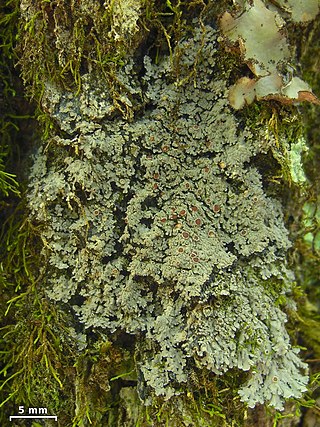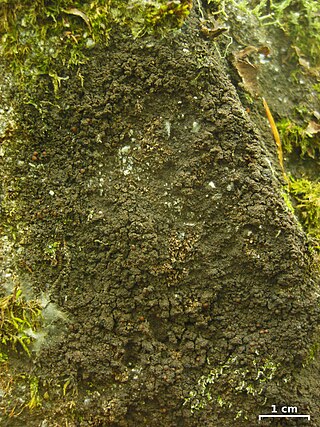
Fuscopannaria is a genus of lichen-forming fungi in the family Pannariaceae. It has 55 species.

Vahliella is a genus of nine species of lichen-forming fungi in the order Peltigerales. It is the only member of Vahliellaceae, a family circumscribed in 2010 to contain this genus. Vahliella was formerly placed in the family Pannariaceae until molecular phylogenetics showed that it did not belong there. Vahliella species are found in the Northern Hemisphere – mainly in North America, but also in Europe and India.
Per Magnus Jørgensen is a Norwegian botanist and lichenologist, and Professor Emeritus of systematic botany at the University of Bergen. He is known for his work on the lichen families Pannariaceae and Collemataceae. Jørgensen was awarded the Acharius Medal in 2021 for his lifetime contributions to lichenology.
Acantholichen pannarioides is a species of basidiolichen in the family Hygrophoraceae, and the type species of genus Acantholichen. The lichen has a bluish-tinged, gelatinous thallus with a surface texture that has a powdery to hairy texture. It is found in montane regions of Central America and northern South America, where it grows on forest litter, bark, on bryophytes, and on other lichens.
Arctomia teretiuscula is a rare species of squamulose (scaly) lichen in the family Arctomiaceae. It is found at high elevations in the mountains between Tibet and Sichuan, China.
Parmeliella triptophylloides is a species of corticolous (bark-dwelling) lichen in the family Pannariaceae. Found in east Africa, it was formally described as a new species in 2003 by Norwegian lichenologist Per Magnus Jørgensen. The type specimen was collected by Dutch mycologist Rudolf Arnold Maas Geesteranus in 1949, from the Cherang'any Hills at an elevation of 900 m (3,000 ft). In addition to the type locality, it has also been recorded from the Luhangalo Plateau in Tanzania.

Lepidocollema marianum is a species of cyanolichen in the family Pannariaceae. It was first scientifically described by Elias Fries in 1825 as Parmelia mariana. Per Magnus Jørgensen transferred it to the genus Lepidocollema in 2014 following a molecular phylogenetics-guided revision of the Pannariaceae.
Fuscopannaria albomaculata is a species of squamulose (scaley), corticolous (bark-dwelling) lichen in the family Pannariaceae. Found in China, it was formally described as a new species in 2004 by Norwegian lichenologist Per Magnus Jørgensen. The type specimen was collected from Hailuogou Glacier Forest Park at an elevation between 2,940 and 3,130 m. The lichen grows on deciduous trees, especially birch and willow, in mountainous forests near glaciers, at elevations between 3,000 and 4,000 m. It is distinguished from other members of genus Fuscopannaria by the white spots on its thallus.
Fuscopannaria hirsuta is a species of squamulose (scaley), corticolous (bark-dwelling) lichen in the family Pannariaceae. Found in China, it was formally described as a new species in 2004 by Norwegian lichenologist Per Magnus Jørgensen. The type specimen was collected from the Nyenchen Tanglha Mountains in Tibet at an elevation of 2,500 m (8,200 ft), where it was found growing on Salix bark. It has also been recorded growing on Juniperus bark. The species epithet hirsuta refers to the hairy upper thallus surface, the first in genus Fuscopannaria with this characteristic.
Fuscopannaria granulifera is a species of squamulose (scaley), corticolous (bark-dwelling) lichen in the family Pannariaceae. Found in India, it was formally described as a new species in 2004 by Norwegian lichenologist Per Magnus Jørgensen. The type specimen was collected from the Great Himalayan National Park at an elevation of 3,140 m (10,300 ft). It is only known to occur in the upper forests of western Himalayas. F. granulifera is the only corticolous member of its genus that has a green algal photobiont; all others have a cyanobacterial photobiont.
Fuscopannaria dispersa is a species of corticolous (bark-dwelling), squamulose lichen in the family Pannariaceae. It is found in China, where it grows on the bark of several tree species at an elevation range from 3,650 to 4,300 m, close to the forest limit. It was formally described as a new species in 2000 by Norwegian lichenologist Per Magnus Jørgensen. The type specimen was collected by Joseph Rock from the eastern slopes of Likang Snow Range in 1922, and has since been documented in a few locations in eastern China. The lichen has a brown thallus made of small squamules spread out over a distinct black prothallus. Its ascospores are ellipsoid, colourless, lack septa, and measure 15–17 by 9–10 μm. Fuscopannaria dispersa is similar to the more widespread F. leucosticta, but can be distinguished from that species by the squamulose form of its thallus and by its smaller, rounder ascospores.
Fuscopannaria dissecta is a species of corticolous (bark-dwelling), squamulose lichen in the family Pannariaceae. Found in Japan, it was formally described as a new species in 2000 by Norwegian lichenologist Per Magnus Jørgensen. The type specimen was collected by Syo Kurokawa from Mount Kōya at an altitude of 800 m (2,600 ft); there it was found growing on the rotting bark of trees. The lichen has a pale brown thallus that forms irregular patches comprising squamules that about are about 2 mm wide. The squamules are dissected–cut deeply into fine lobes–and it is this character that is referenced in the species epithet dissecta.
Fuscopannaria saltuensis is a species of ground-dwelling, squamulose lichen in the family Pannariaceae. It is found in both the Eastern and Western Himalayas, where it grows on soil in open mountain forests with pastures and cliffs.

Fuscopannaria leucosticta, commonly known as the rimmed shingle lichen, is a species of lichen in the family Pannariaceae. It has a squamulose (scaley) thallus that lacks soredia and isidia, but has abundant apothecia with distinct white rims. Although its main centres of distribution are eastern North America and southeast Asia, where it grows in damp forests, it has been reported from various other high-altitude, humid locations.
Leptogium adnatum is a species of lichen in the family Collemataceae. Found in Cape Horn, the southernmost point of South America, it was formally described as a new species in 2013 by Norwegian lichenologist Per Magnus Jørgensen. The crust-like thallus of the lichen comprises densely packed, intricately folded, irregular squamules that in some parts form dark greyish-blue lobes that are firmly attached to their rock substrate. The species epithet adnatum refers to this tight attachment. Leptogium adnatum is only known to occur on coastal rocks in the Cape Horn region. The coastal locale is unusual for a species of Leptogium, but the author speculates that the high levels of rainfall that occur in the area dilutes the salt concentration sufficiently to make the climate more amenable to the growth of the lichen.
Leptogium auriculatum is a species of foliose lichen in the family Collemataceae. Found in Cape Horn, the southernmost point of South America, it was formally described as a new species in 2013 by Norwegian lichenologist Per Magnus Jørgensen. The type specimen was collected by William R. Buck east of Puerto Williams, where it was found growing on wet rocks along a small stream in a disturbed Nothofagus forest. The leafy thallus of the lichen comprises orbicular, sometimes overlapping lobes, packed, intricately folded, irregular squamules that in some parts form dark greyish-blue lobes with undulating margins and a width of 0.5–1 cm (0.2–0.4 in). The upper thallus surface is more or less smooth, shiny, and dark greyish-brown, while the undersurface is paler and smooth. Leptogium auriculatum is only known to occur on rocks in the Cape Horn region in a couple of difficult-to-access locations.
Pannaria emodii is a species of corticolous (bark-dwelling), squamulose (scaley) to foliose (leafy) lichen in the family Pannariaceae. It was formally described as a new species in 2001 by the Norwegian lichenologist Per Magnus Jørgensen. The type specimen was collected in 1967 by Hiroshi Harada and colleagues from Shodu-Barshong (Bhutan) at an altitude between 3,500 and 3,800 m.
Pannaria complanata is a species of corticolous (bark-dwelling), squamulose (scaley) to foliose (leafy) lichen in the family Pannariaceae. It was formally described as a new species in 2001 by the Norwegian lichenologist Per Magnus Jørgensen. The type specimen was collected from the Doddabetta peak in the Nilgiri Mountains at an altitude of about 3,000 m (9,800 ft). The lichen makes circular patches typically up to about 5 cm (2 in) in diameter, comprising brownish, flat lobes measuring up to 2 mm wide. The photobiont partner is a member of the cyanobacterial genus Nostoc. The PD+ (orange) chemical spot test reaction indicates the presence of pannarin, a lichen product. The geographic range of the lichen includes India, Sri Lanka, and Indonesia. In India it is found only in the Western Ghats, having been recorded from Kerala and Tamil Nadu. In this country Pannaria complanata often associates with moss genus Hyophila.
Pannaria ramulosa is a species of corticolous (bark-dwelling), squamulose (scaly) to foliose (leafy) lichen in the family Pannariaceae. It was formally described as a new species in 2001 by the Norwegian lichenologist Per Magnus Jørgensen. Gustaf Einar Du Rietz collected the type specimen in 1927 from the Goenoeng Ardjoena. This rainforest lichen has a rounded thallus up to 5 cm (2 in) in diameter with thin, brownish lobes. It does not show any reactions to standard chemical spot tests, and no lichen products were detected using thin-layer chromatography. At the time of its original publication it was only known to occur at the type locality.
Pannaria formosana is a species of corticolous (bark-dwelling), squamulose (scaley) to foliose (leafy) lichen in the family Pannariaceae. Found in eastern Asia, it was formally described as a new species in 2001 by the Norwegian lichenologist Per Magnus Jørgensen. The type specimen was collected in February, 1965 by Syo Kurokawa from Chinsueiin Pass,.



